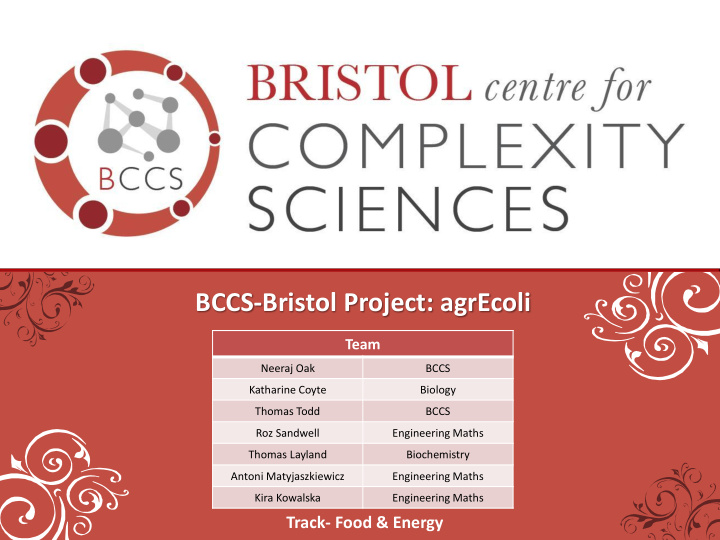



BCCS-Bristol Project: agrEcoli Team Neeraj Oak BCCS Katharine Coyte Biology Thomas Todd BCCS Roz Sandwell Engineering Maths Thomas Layland Biochemistry Antoni Matyjaszkiewicz Engineering Maths Kira Kowalska Engineering Maths Track- Food & Energy
Contents What is agrEcoli? Part design and construction Modelling Publicising agrEcoli
Precision Farming Aimed at arable farmers Fertilise only where needed Saves money Saves fertiliser
Environmental Costs 7 Tonnes of CO 2 Equivalent → 1 tonne of fertiliser Causes eutrophication
Top Soil Deep Soil Soil Cross-Section
Nutrients Location
Contents What is agrEcoli? Part design and construction Modelling Publicising agrEcoli
Part Design Nitrate sensitive promoter PyeaR T T T T RBS GFP Why PyeaR? Proteins involved native to E. coli Independent of metabolic state
How does PyeaR work? Nitrates Nitrate breakdown products PyeaR NsrR RBS GFP
How does PyeaR work? PyeaR NsrR RBS GFP
How does PyeaR work? PyeaR PyeaR T T T T RBS GFP Why GFP? Detectable Quantifiable No substrate required
Results and Initial Characterization Tested transformants in solution containing varying levels of potassium nitrate It works!
Detecting Signal in Soil Signal needs to be detectable in soil Performed several experiments looking at behaviour of E. coli constitutively expressing GFP in soil Raised two major problems: Hard to detect Many weakly fluorescing bacteria or a few strong ones? Need to know the number of cells to map from fluorescence magnitude to concentration of nitrate
Using a Ratio Created E. coli constitutively expressing RFP Measure the ratio of red to green MG1655 Compare this against some scale to indicate soil nitrate GFP RFP levels How to solve the problem of colony size difference? The Ratio
Using a Ratio Consulted with farmers about typical soil nitrate levels Tested the transformants further within this range: 0 – 2mM potassium nitrate Used this data to calculate a relationship between signal ratio and nitrate level
Beads How to solve the problem of signal detection? A higher concentration of agrEcoli Better access to nitrate Cell encapsulation in gel facilitates this Gellan gel Pipette drops Cool, mix with Make mixture, into ionic Agitate and dense agrEcoli heat solution to store in broth slurry initiate gellation
Contents What is agrEcoli? Part design and construction Modelling Publicising agrEcoli
BSim through the ages BSim 2008 – stochastic agent based simulation in a fluid environment BSim 2009 – robust modular components, well parameterised BSim 2010 – Full graphical user interface, micro- environmental interactions
BSim through the ages BSim 2008 – stochastic agent based simulation in a fluid environment BSim 2009 – robust modular components, well parameterised BSim 2010 – Full graphical user interface, micro- environmental interactions
BSim through the ages BSim 2008 – stochastic agent based simulation in a fluid environment BSim 2009 – robust modular components, well parameterised BSim 2010 – Full graphical user interface, micro- environmental interactions
BSim through the ages BSim 2008 – stochastic agent based simulation in a fluid environment BSim 2009 – robust modular components, well parameterised BSim 2010 – Full graphical user interface, micro- environmental interactions
BSim through the ages… BSim 2008 – stochastic agent based simulation in a fluid environment BSim 2009 – robust modular components, well parameterised BSim 2010 – Full graphical user interface, micro- environmental interactions
Modelling Environmental Interactions Cell encapsulation Micro fluidics Bio-films
New Modelling Capabilities
New Modelling Capabilities
Modelling the Beads Confocal scan of bead Create mesh Model in BSim
BSim Feature Comparison Feature GUI Intracellular Dynamics Multicellular Dynamics Environmental Interaction
Contents What is agrEcoli? Part design and construction Modelling Publicising agrEcoli
Wider context of our research Functional prototype Engaging the public in synthetic biology Our project as a hypothetical product Building on previous teams’ work Our new idea: a publicity campaign
Public perception More public information required Scientific community input Safety and security Opinions forming on synthetic biology
Product Information Flyer product description safety features environmental motivation E. coli & legislation information
What can we do with this campaign? Bringing real beads to market Legalities of releasing GMOs Explore patenting and protection Acquire endorsements from trusted organisations For next year’s competition Collaboration: many team leaflets advertising their products Science fairs and public discussion Publicity approach promotes our research and its potential
Summary Well characterised working prototype Novel delivery method Extended our modelling framework, BSim, and used it to analyse behaviour in beads New approach to human practices through publicising agrEcoli See wiki for more- 2010.igem.org/Team:BCCS-Bristol
Sponsors Supervisors Nigel Savery Biochemistry Claire Grierson Biology Mario di Bernardo Engineering Maths Krasimira Tsaneva-Atanasova Engineering Maths Caroline Colijn Engineering Maths John Hogan BCCS Paul Verkade Biochemistry
Recommend
More recommend